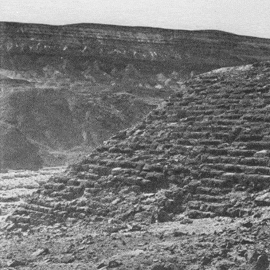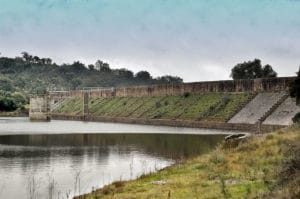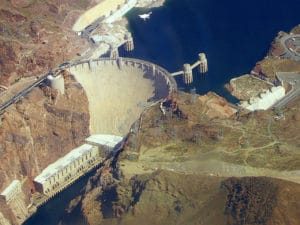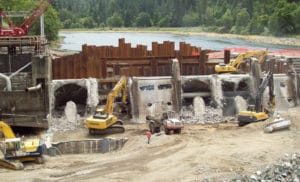There are over 87,000 dams in the United States. With one-third of those dams posing a serious threat to people’s lives and property if they fail, dam safety is nothing to ignore. Dams are a critical part of our infrastructure providing flood protection, water supply, hydropower, irrigation, and recreation. Although dam safety may not seem to be a big concern, dam failure can affect people for miles and miles, with sometimes fatal results. National Dam Safety Awareness Day is a day to acknowledge the progress we have made in making our dams safe structures and the continuous progress we still have yet to make.
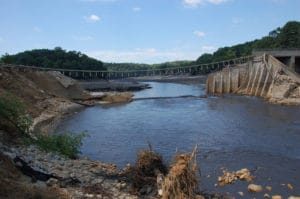
As our population keeps growing, our dams are getting older and some are even deteriorating. A dam can fail within hours of the first signs of breeching. Dam safety is a shared responsibility. Dam owners, engineers, community planners, along with federal and state leaders all have important roles in keeping dams running efficiently and safely.
The National Dam Safety Program (NDSP), led by FEMA, has been working for 30 years to keep Americans safe from dam failures. The NDSP assists states in establishing and maintaining dam safety programs along with providing technical training to state and federal dam safety staff. Their support for research and development has greatly helped raise awareness about improper dam safety along with lessening the impact on a community if a dam were to fail.
Why Dams Fail
One of the most frequent ways dams fail is overtopping. Overtopping is a strong indicator of an unsafe dam. This can happen due to a number of reasons but typically it is from inadequate spillway design, debris blockage, or settlement of the dam crest. Overtopping accounts for about 34% of all dam failures in the United States and can also lead to erosion of the downstream face of the dam. Without proper maintenance of the downstream face, the dam is at a heightened risk of failure. Wind and other harsh weather conditions can cause waves to erode the upstream face which can make the dam unsafe during heavy rainfall or flash floods.
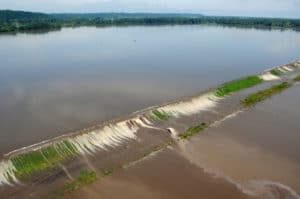
Other important factors that can cause dam failure are seepage and foundation defects. These defects account for about 30% of dam failures in the US, typically due to slide failure. If seepage or other factors weaken the soil supporting a dam, the overall strength of the dam greatly diminishes, creating the potential for a landslide-like affect.
Improper construction measures such as insufficient soil testing also contribute to dam failures. When permeable cavities or course gravel are present in dam foundations, seepage is a big concern because it erodes the soil at a fast rate. This often results in the dam settling or sinking which causes failure. A dam can fail by water passing under, over, through, or around it. Every dam should be properly connected to the ground and constructed using the best materials and methods to meet current design and construction standards.
How to Prevent Failures
When constructing and maintaining a dam, taking the proper engineering steps is vital. For example, completing sufficient soil tests prior to construction helps ensure that the dam will be adequately supported. The soil on the actual site should be examined before any detailed planning is put into place. It is also important to confirm the existence of impervious clay to seal the excavation and form the core of the bank. Failures can be prevented if the contractor is aware of any soil limitations at the site.
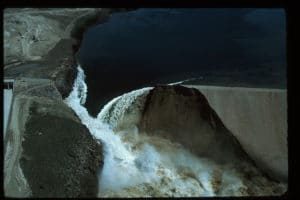
Dam failures have taken the lives of hundreds of people in recent decades so it is important to hire the right contractors to do the proper work. Nothing can take the place of a reliable and reputable contractor. Having experienced engineers and machine operators greatly reduces the risk of failure. It is important to review every employee’s credentials before starting a job and to always seek professional advice from an engineer when planning and designing a dam. Improper construction and inspection can lead to a weak structure, which can be dangerous and, sometimes, even fatal.
Maintenance and inspection must be routinely completed in order to keep dams safe. If a problem associated with a dam is not addressed in a timely manner, it can become more dangerous as time goes on. Dam inspectors should document every inspection in order to accurately assess needed repairs. While maintaining a dam, vegetation control, erosion repair, and clearing debris from spillways should be a routine practice. A healthy layer of grass can help prevent erosion, and any debris within 25 feet of the dam should be removed. A poorly maintained dam can cost the owner more to repair than a dam which is regularly inspected and checked for needed repairs.
Emergency Action Plans
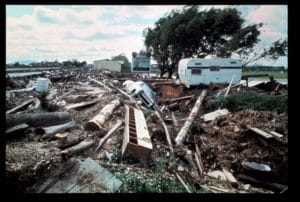
173 dams across the country have failed since 2005 so it is important to know what your community’s Emergency Action Plan (EAP) is if a local dam were to fail. An up-to-date EAP is critical to reduce the risk of lost lives and property damage. A good EAP accomplishes three main goals: identify the area below the dam that would be flooded, establish a line of communication for the dam owner and emergency response, and provide warnings and evacuations to be conducted by local emergency teams. Below are the six essential elements of a successful EAP.
- Notification Flowchart. This is to identify who should be notified by whom, and in what priority. This information is crucial for the notification of the persons in charge of taking emergency actions. The flowchart should have detailed information about each position in the chart such as title, office, and multiple ways of contacting that individual. EAPs should include the residents and businesses downstream of the dam that should be notified in case of an emergency. Proper communication and assigned roles can drastically reduce the impacts of a dam failure.
- Emergency Detection, Evaluation, and Classification. This ensures that the appropriate course of action is taken based on the urgency of the situation. Having procedures in place to classify an emergency situation properly will better prepare a community to activate their EAP before a catastrophe occurs. Early detection of a potential problem can save hundreds of lives and millions of dollars in property damage.
- Responsibilities. When an emergency occurs, everyone should know their role in reacting to the situation. Typically, the dam owner’s responsibilities include developing, maintaining, and implementing the EAP while state and emergency management officials are responsible for warning and evacuation. Without proper assignment of responsibilities, the EAP would be ineffective.
- Preparedness. This section outlines actions to be taken before an emergency occurs. Preparedness actions are taken to moderate or minimize the effects of a dam failure and to identify specific responses to be taken in emergencies.
- Inundation Maps. An inundation map identifies the areas affected if a dam were to fail. This map is important in identifying a strategy to notify and evacuate areas in danger. These maps graphically display flooded areas and show travel times for wave front and flood peaks at critical locations.
- Appendices. This section contains information directly applicable to the actions of the dam owner and the emergency management parties. The appendices provide information that supports the material used to develop the EAP such as maintenance requirements and dam break investigations.
In Conclusion
Dams serve an important role in our nation’s infrastructure. Millions of people in every state rely on dams to bring them benefits such as flood control, water supply, irrigation, recreational areas, and renewable energy. Safe operation and maintenance is important to sustaining these advantages and avoiding disasters which are very often preventable. Dams fail for a number of reasons but the primary source of failure is poor inspection and maintenance, inadequate design, and improper operation. Know your risk when it comes to dam failure in your community. Getting familiar with your community’s EAP and level of risk from a dam failure can greatly help you in an emergency situation. National Dam Safety Awareness Day is an opportunity to raise awareness about our nations deteriorating dams and to take steps in making them safer structures for our community.
Happy National Dam Safety Awareness Day!

 Memorial Day is the generally accepted start of summer to most New England communities. Pools are opened, grills are wheeled out from storage, flowers are planted, and beaches are officially opened. And while summer is absolutely breathtaking in New England, it is also a time of increased stress on water quality and supply.
Memorial Day is the generally accepted start of summer to most New England communities. Pools are opened, grills are wheeled out from storage, flowers are planted, and beaches are officially opened. And while summer is absolutely breathtaking in New England, it is also a time of increased stress on water quality and supply.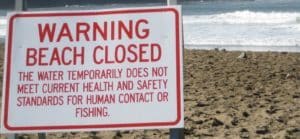 Unfortunately, because of the huge popularity of beaches in the summer, water quality can suffer. Beach closures are common during the summer months, and are a result of pollutants and pathogens entering the water. One of the most common sources of water pollution is human fecal matter from leaky septic systems and sewer overflows. Human waste contains a variety of harmful organisms, including bacteria, viruses, and parasites, that can cause illnesses such as gastroenteritis, hepatitis, and skin infection to humans. Another source of pollution is animal fecal matter from agricultural and stormwater runoff. While runoff contains a number of pollutants including motor oil, pesticides, fertilizers, and trash, arguably the most dangerous and disruptive is animal feces. A single gram of dog feces contains over 23 million parvovirus bacteria in addition to whipworms, hookworms, roundworms, threadworms, giardia, and coccidian. These pathogens and parasites enter waterways through runoff and can have detrimental effects on waterways, aquatic life, and humans.
Unfortunately, because of the huge popularity of beaches in the summer, water quality can suffer. Beach closures are common during the summer months, and are a result of pollutants and pathogens entering the water. One of the most common sources of water pollution is human fecal matter from leaky septic systems and sewer overflows. Human waste contains a variety of harmful organisms, including bacteria, viruses, and parasites, that can cause illnesses such as gastroenteritis, hepatitis, and skin infection to humans. Another source of pollution is animal fecal matter from agricultural and stormwater runoff. While runoff contains a number of pollutants including motor oil, pesticides, fertilizers, and trash, arguably the most dangerous and disruptive is animal feces. A single gram of dog feces contains over 23 million parvovirus bacteria in addition to whipworms, hookworms, roundworms, threadworms, giardia, and coccidian. These pathogens and parasites enter waterways through runoff and can have detrimental effects on waterways, aquatic life, and humans.
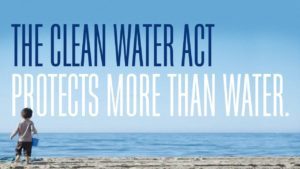 Fortunately, there are policies and regulations in place that directly address seasonal water quality and quantity issues. The EPA, along with other governmental agencies, have enacted several laws that aim to protect the quality of our nation’s beaches:
Fortunately, there are policies and regulations in place that directly address seasonal water quality and quantity issues. The EPA, along with other governmental agencies, have enacted several laws that aim to protect the quality of our nation’s beaches: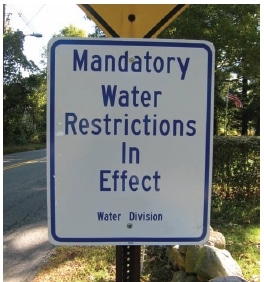 Outdoor water restrictions and bans: Many communities implement water bans in the summer that severely limit or prohibit outdoor watering.
Outdoor water restrictions and bans: Many communities implement water bans in the summer that severely limit or prohibit outdoor watering. Beaches are one of the most traditional and enjoyable means of summer entertainment for families and individuals, and they provide a plethora of recreational activities for all ages. Protecting our beaches and recreational waters is imperative to the health of our nation’s citizens and economy, and we are fortunate that our nation’s governmental agencies and local communities proactively work to maintain the health of our waters. We as individuals can also help to protect our beaches and waterways by reducing our personal water consumption, cleaning up after our pets, and being mindful of pesticide and fertilizer usage. Together, we can assure that present and future generations are able to enjoy our nation’s beautiful beaches.
Beaches are one of the most traditional and enjoyable means of summer entertainment for families and individuals, and they provide a plethora of recreational activities for all ages. Protecting our beaches and recreational waters is imperative to the health of our nation’s citizens and economy, and we are fortunate that our nation’s governmental agencies and local communities proactively work to maintain the health of our waters. We as individuals can also help to protect our beaches and waterways by reducing our personal water consumption, cleaning up after our pets, and being mindful of pesticide and fertilizer usage. Together, we can assure that present and future generations are able to enjoy our nation’s beautiful beaches.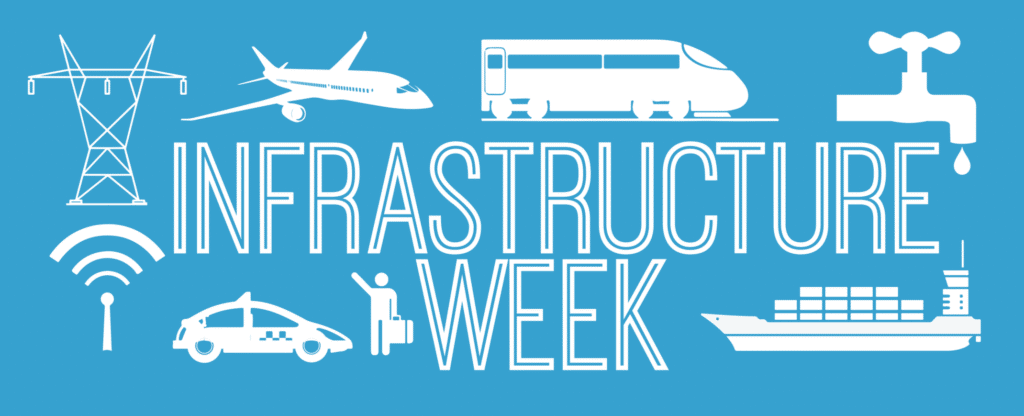 It is scary to realize how complacent our country has become in accepting crumbling infrastructure as the norm. Our international competitors are investing more in high speed rail, modern airports, and bigger shipping ports, while just about every few months, some kind of preventable catastrophic infrastructure event happens in America. Yet our leaders are still not spurred into taking decisive action.
It is scary to realize how complacent our country has become in accepting crumbling infrastructure as the norm. Our international competitors are investing more in high speed rail, modern airports, and bigger shipping ports, while just about every few months, some kind of preventable catastrophic infrastructure event happens in America. Yet our leaders are still not spurred into taking decisive action.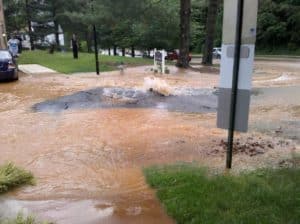

 During Infrastructure Week, groups are coming together to recognize progress and leadership at the federal, state, and local levels – and there is much to celebrate. For example, communities throughout New England have been proactive in lead service line replacement, and the Massachusetts Water Resources Authority
During Infrastructure Week, groups are coming together to recognize progress and leadership at the federal, state, and local levels – and there is much to celebrate. For example, communities throughout New England have been proactive in lead service line replacement, and the Massachusetts Water Resources Authority 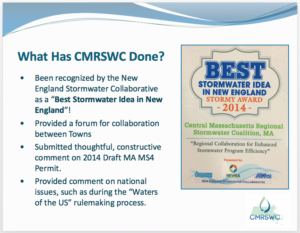 On Wednesday, May 18, 2016, the Association to Preserve Cape Cod (APCC), the Barnstable Coastal Resources Committee, the Cape Cod Commission, and the Massachusetts Bays National Estuary Program hosted a free workshop entitled “2016 Small MS4 Stormwater Permit for Massachusetts and Stormwater Collaboratives.” The event, which was very well attended, was held at Cape Cod Community College and featured several presentations, including the keynote by Mr. Newton Tedder, MS4 Program, Region 1, US EPA, on “2016 Final Massachusetts Small MS4 General Permit for Stormwater.” Mr. Tedder, a key contributor to the revised permit, was available for questions. Also presenting at the workshop were Tata & Howard’s Stormwater Manager Jon Gregory, P.E., and Cherry Valley & Rochdale Water District Superintendent Michael Knox. Both Jon and Mike presented on the Central Massachusetts Regional Stormwater Coalition (CMRSWC), of which the Town of Leicester — which includes the Villages of Cherry Valley and Rochdale — is a member. The presentations included information which provided an overview of the CMRSWC as well as specific products and benefits. Congratulations to both Jon and Mike for their presentations, which provided clear and compelling data on the value of a regional stormwater collaborative.
On Wednesday, May 18, 2016, the Association to Preserve Cape Cod (APCC), the Barnstable Coastal Resources Committee, the Cape Cod Commission, and the Massachusetts Bays National Estuary Program hosted a free workshop entitled “2016 Small MS4 Stormwater Permit for Massachusetts and Stormwater Collaboratives.” The event, which was very well attended, was held at Cape Cod Community College and featured several presentations, including the keynote by Mr. Newton Tedder, MS4 Program, Region 1, US EPA, on “2016 Final Massachusetts Small MS4 General Permit for Stormwater.” Mr. Tedder, a key contributor to the revised permit, was available for questions. Also presenting at the workshop were Tata & Howard’s Stormwater Manager Jon Gregory, P.E., and Cherry Valley & Rochdale Water District Superintendent Michael Knox. Both Jon and Mike presented on the Central Massachusetts Regional Stormwater Coalition (CMRSWC), of which the Town of Leicester — which includes the Villages of Cherry Valley and Rochdale — is a member. The presentations included information which provided an overview of the CMRSWC as well as specific products and benefits. Congratulations to both Jon and Mike for their presentations, which provided clear and compelling data on the value of a regional stormwater collaborative.
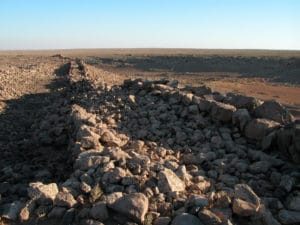 The first known dam to be built is the Jawa Dam, which is actually the largest in a series of dams that are all part of one reservoir system. Located in modern-day Jordan, the Jawa Dam was originally constructed around 3,000 BCE in what was then Mesopotamia. Surprisingly, the Jawa Dam was actually an architectural feat of the times. While most ancient dams were simple gravity dams constructed of gravel and masonry, the Jawa Dam was reinforced with rock fill behind the upstream wall in order to protect the wall from water pressure breach. This safety feature was incredibly innovative for this time period. Unfortunately, the reinforced design was forgotten after the Jawa Dam and was not actually “reinvented” until modern times. The Jawa Dam site is arguably the most important archaeological site in the history of large-scale water projects, and the dam itself was so well designed and constructed that the ancient structure stood until just a few years ago, when it was partially ruined due to physical intervention. In its prime, the Jawa Dam was 15 feet tall, 80 feet long, with a base of 15 feet. It created the Jawa Reservoir that had a capacity of 1.1 million cubic feet.
The first known dam to be built is the Jawa Dam, which is actually the largest in a series of dams that are all part of one reservoir system. Located in modern-day Jordan, the Jawa Dam was originally constructed around 3,000 BCE in what was then Mesopotamia. Surprisingly, the Jawa Dam was actually an architectural feat of the times. While most ancient dams were simple gravity dams constructed of gravel and masonry, the Jawa Dam was reinforced with rock fill behind the upstream wall in order to protect the wall from water pressure breach. This safety feature was incredibly innovative for this time period. Unfortunately, the reinforced design was forgotten after the Jawa Dam and was not actually “reinvented” until modern times. The Jawa Dam site is arguably the most important archaeological site in the history of large-scale water projects, and the dam itself was so well designed and constructed that the ancient structure stood until just a few years ago, when it was partially ruined due to physical intervention. In its prime, the Jawa Dam was 15 feet tall, 80 feet long, with a base of 15 feet. It created the Jawa Reservoir that had a capacity of 1.1 million cubic feet.